

Iguanas
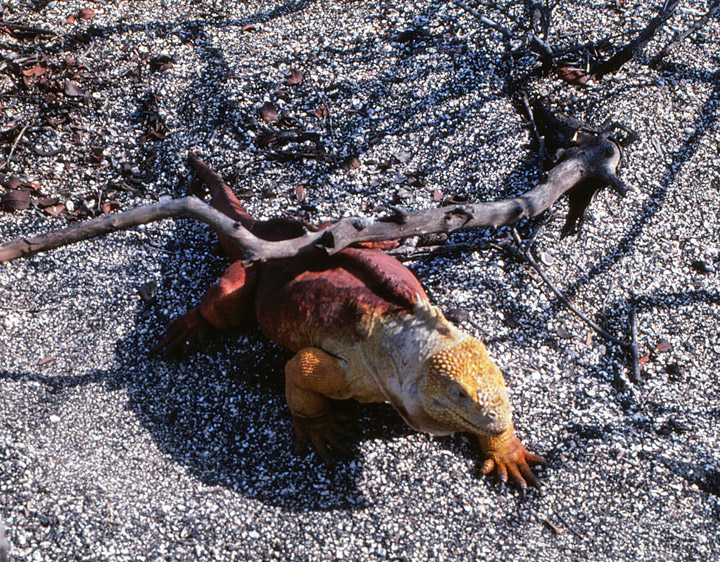
Galapagos Land Iguana
The Galapagos Land Iguana (Conolophus subcristatus) is a species of lizard in the Iguanidae family. It is one of two species of the genus Conolophus. It is endemic to the Galápagos Islands, primarily the islands of Fernandina, Isabela, Santa Cruz, North Seymour, Hood and South Plaza.
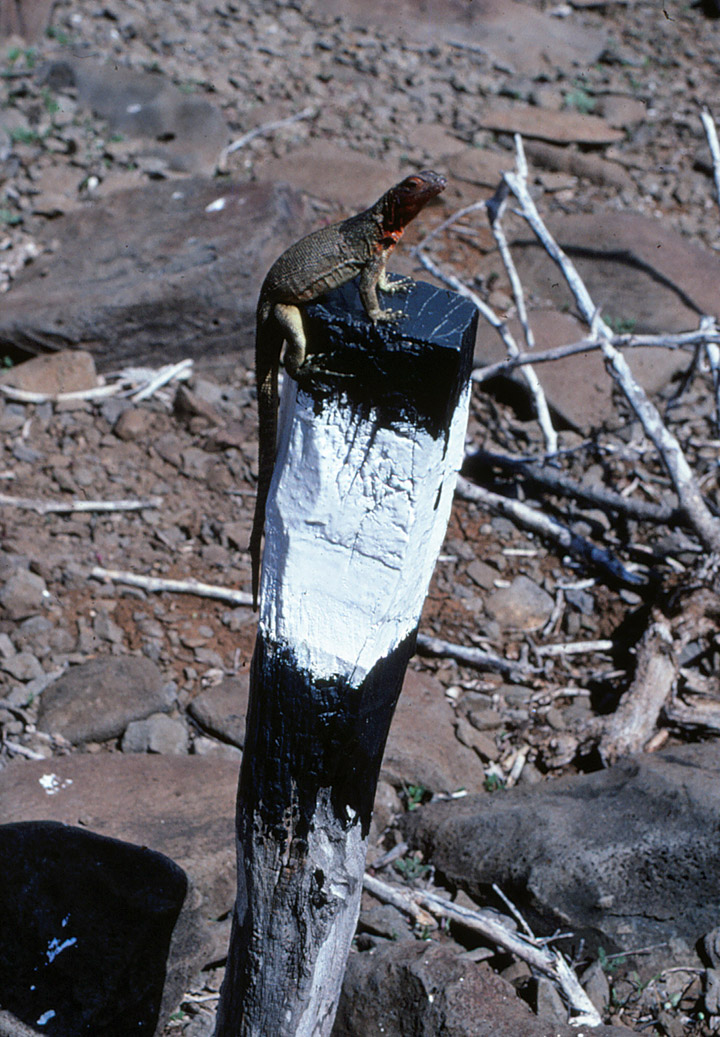
The Galapagos Land Iguana varies in morphology and coloration among different
island populations. There are two taxonomically distinct forms of Conolophus
inhabiting the western part of the islands (C. cristatus and C. pallidus) and
one in the central part (C. cristatus). Its generic name, Conolophus, is derived
from two Greek words: cono meaning "spiny" and loph meaning "crest", denoting
the spiny crests along their backs. Its specific name subcristatus is derived
from the Latin words sub meaning "lesser" and cristatus meaning "crested," and
refers to the low crest of spines along the animal's back which is not as tall
as in most iguanids.
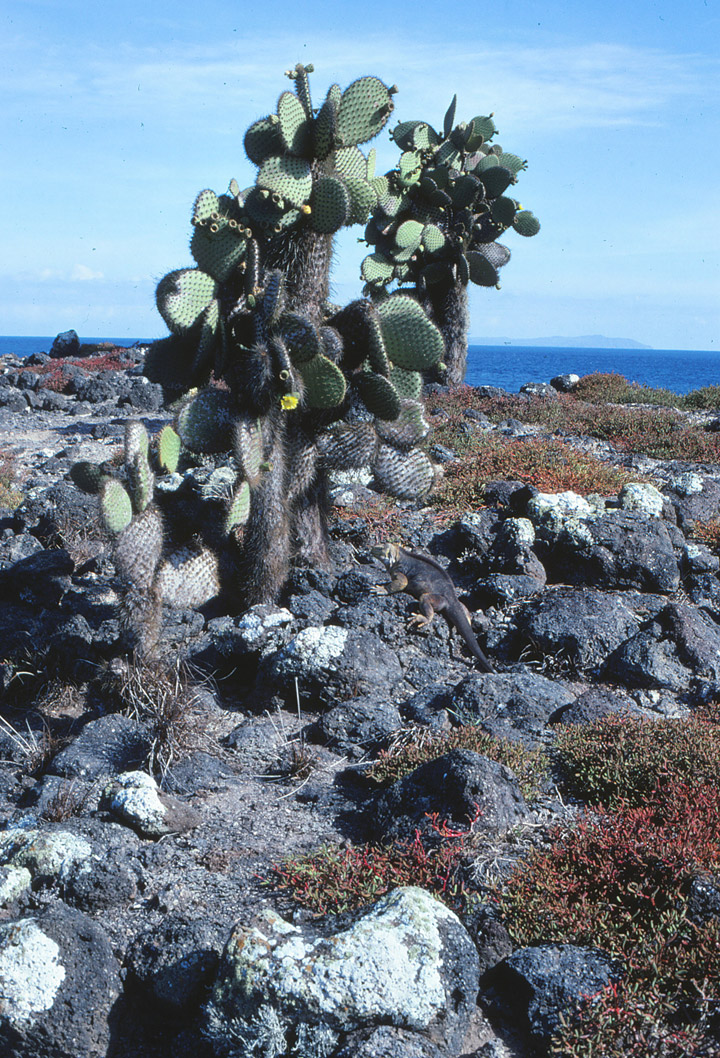
Charles Darwin described the Galapagos Land Iguana as "ugly animals, of a
yellowish orange beneath, and of a brownish-red color above: from their low
facial angle they have a singularly stupid appearance." The Galapagos Land
Iguana grows to a length of three to five feet with a body weight of up to
twenty-five pounds, depending upon which island they are from. Being
cold-blooded, they absorb heat from the sun by basking on volcanic rock, and at
night sleep in burrows to conserve their body heat. These iguanas also enjoy a
symbiotic relationship with birds; the birds remove parasites and ticks,
providing relief to the iguanas and food for the birds.
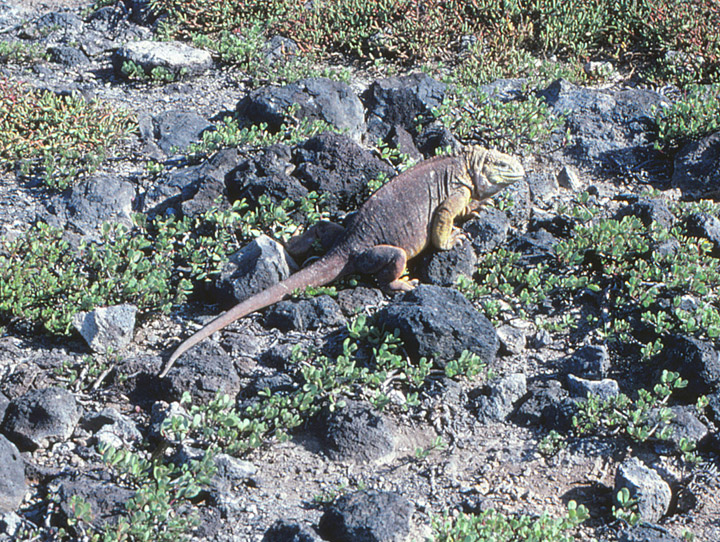
Land iguanas are primarily herbivorous; however, some individuals have shown
that they are opportunistic carnivores supplementing their diet with insects,
centipedes and carrion. Because fresh water is scarce on the islands it
inhabits, the Galapagos Land Iguana obtains the majority of its moisture from
the prickly-pear cactus that makes up 80% of its diet: fruit, flowers, pads, and
even spines. During the rainy season it will drink from available standing pools
of water and feast on yellow flowers of the genus Portulaca.
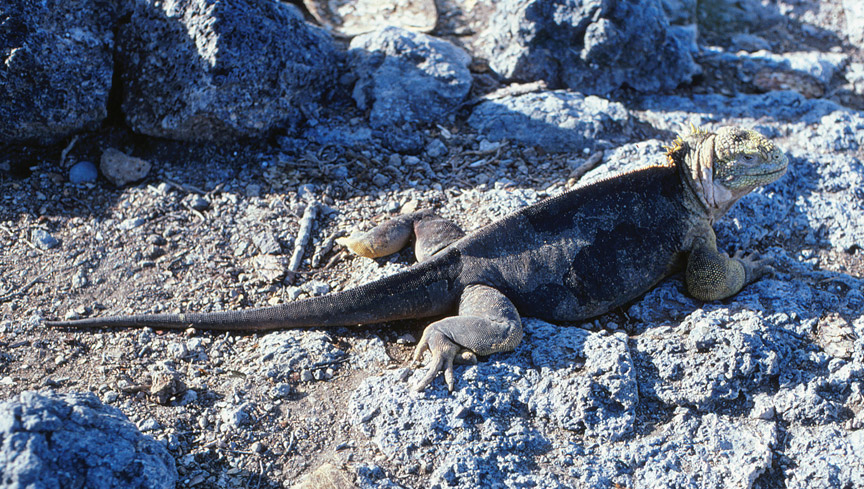
It is estimated that the Galapagos Land Iguana has a 60-year lifespan.
Galapagos Land iguanas become sexually mature anywhere between eight and fifteen
years of age, depending on which island they are from. Mating season also varies
between islands, but soon after mating, the females migrate to sandy areas to
nest, laying 2-25 eggs in a burrow 18 inches deep. The eggs hatch anywhere from
90 to 120 days later.
On South Plaza Island, where the territories of Marine Iguanas and Land Iguanas
overlap, the two sometimes interbreed, resulting in a mixture of features from
each species. The most likely unions tend to be between male Marine Iguanas and
Female Land Iguanas. Despite their long separation time and their being two
distinct species from different genera, the offspring are viable, although
likely sterile.

It is estimated that between 5,000 and 10,000 land iguanas are found in the
Galapagos. These iguanas were so abundant on Santiago Island at one time that
naturalist Charles Darwin remarked when it was called King James Island that
"...when we were left at James, we could not for some time find a spot free from
their burrows on which to pitch our single tent". In the years since then,
entire populations (including all the animals on Santiago Island) have been
wiped out by introduced feral animals such as pigs, rats, cats, and dogs.
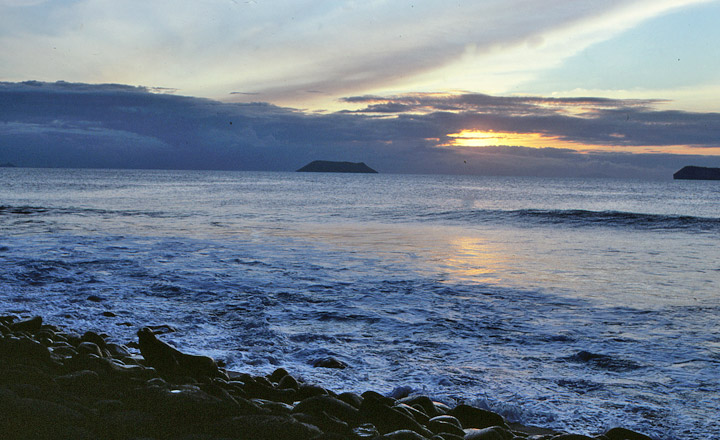
The biggest threat to Galapagos Land Iguanas is from feral animals introduced by
humans to the islands. Feral dogs and cats attack the iguanas and destroy
their nests; the iguanas, having lived in isolation for millions of years, never
developed any instincts to flee from predators. Feral pigs destroy the nests of
iguanas while searching for food and even eat the eggs of the lizards. This is
common in Cerro Azul volcano and Isabela, and in Santiago pigs may be the cause
of the disappearance of the land iguanas that were so abundant when Darwin
visited. Introduced goats are a major competitor for food and water; and
overbrowsing by goats also leads to loss of protective cover from birds of prey
such as the Galapagos Hawk.
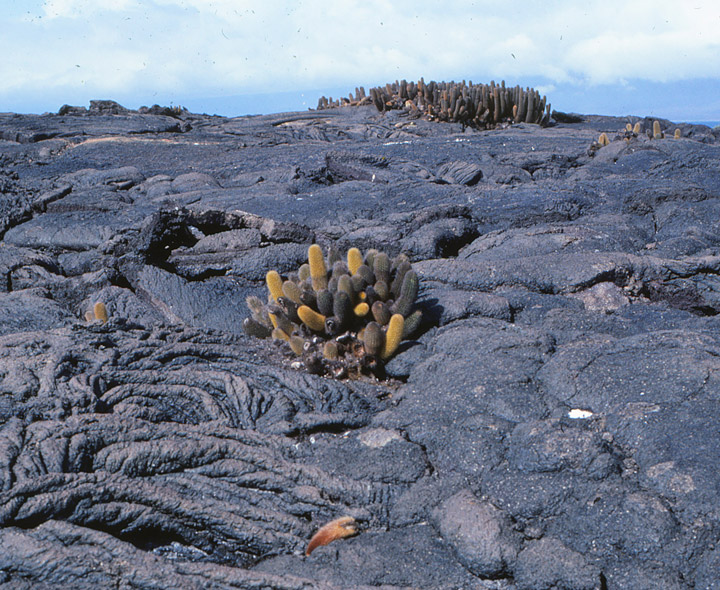
vegetation on the broken lava surface
The Galapagos Land Iguana is the subject of an active re-introduction campaign on Baltra Island; it became extinct on Baltra by 1954, allegedly wiped out by soldiers stationed there who shot the iguanas for amusement. However, in the early 1930s, William Randolph Hearst had translocated a population of Land Iguanas from Baltra to North Seymour Island, a smaller island just a few hundred meters north of Baltra because he could not understand why no iguanas were present there. Hearst's translocated iguanas survived, and became the breeding stock for the Charles Darwin Research Station captive breeding program which has successfully reintroduced the species to Baltra and a number of other areas.
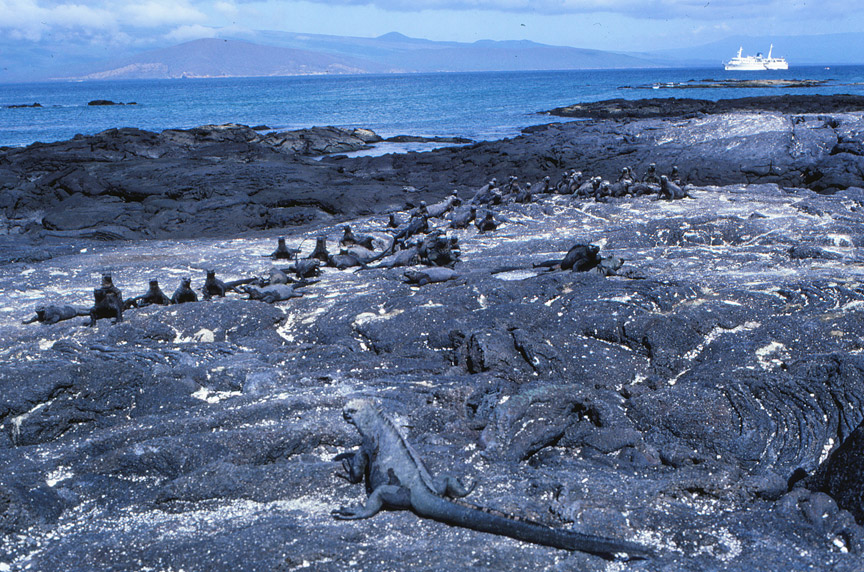
Marine Iguana
The Marine Iguana (Amblyrhynchus cristatus) is an iguana that has the unique ability among modern lizards to live and forage in the sea. It is found only on the Galapagos Islands, but has spread to all the islands in the archipelago, and is sometimes called the Galapagos Marine Iguana. It mainly lives on the rocky Galapagos shore, but can also be spotted in marshes and mangrove beaches.
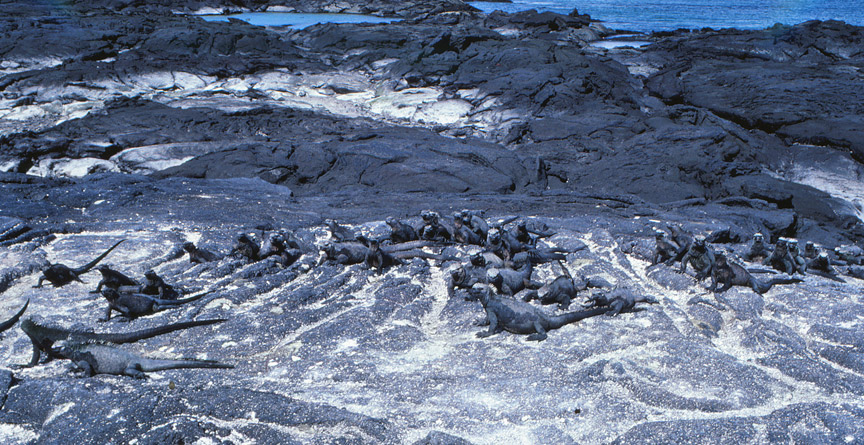
On his visit to the islands, Charles Darwin was revolted by the animals'
appearance, writing:
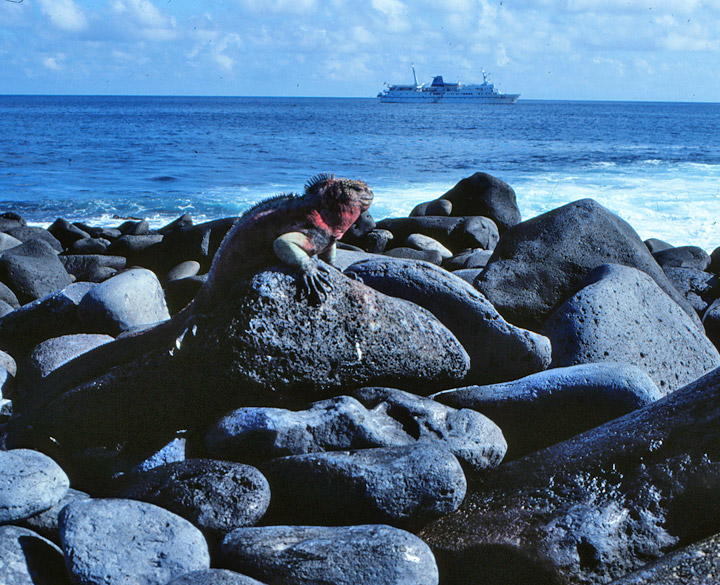
The black Lava rocks on the beach are frequented by large (2-3 ft) most
disgusting clumsy Lizards. They are as black as the porous rocks over which they
crawl & seek their prey from the Sea. I call them 'imps of darkness'. They
assuredly well become the land they inhabit.
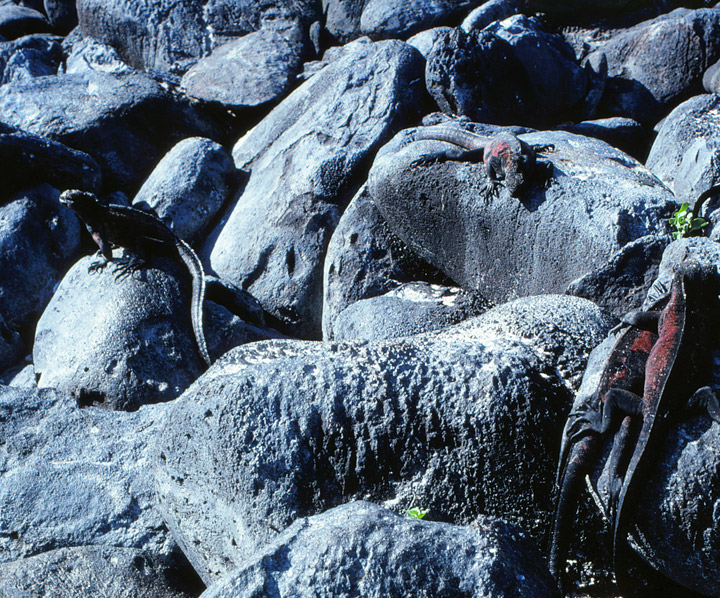
In fact, Amblyrhynchus cristatus is not always black; the young have a lighter
colored dorsal stripe, and some adult specimens are grey. The reason for the
sombre tones is that the species must rapidly absorb heat to minimize the period
of lethargy after emerging from the water. They feed almost exclusively on
marine algae, expelling the excess salt from nasal glands while basking in the
sun, and the coating of salt can make their faces appear white. In adult males,
coloration varies with the season. Breeding-season adult males on the southern
islands are the most colorful and will acquire reddish and teal-green colors,
while on Santa Cruz they are brick red and black, and on Fernandina they are
brick red and dull greenish.
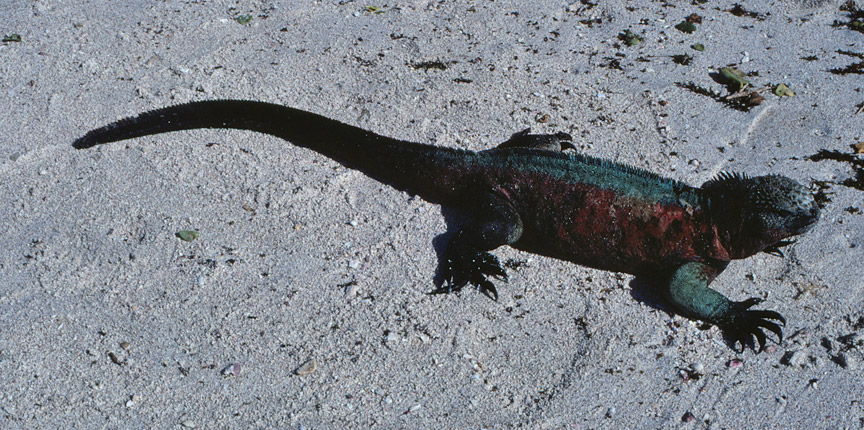
Another difference between the iguanas is size, which is different depending on
the island the individual iguana inhabits. The iguanas living on the islands of
Fernandina and Isabela (named for the famous rulers of Spain) are the largest
found anywhere in the Galápagos. On the other end of the spectrum, the smallest
iguanas are found on the island on Genovesa.
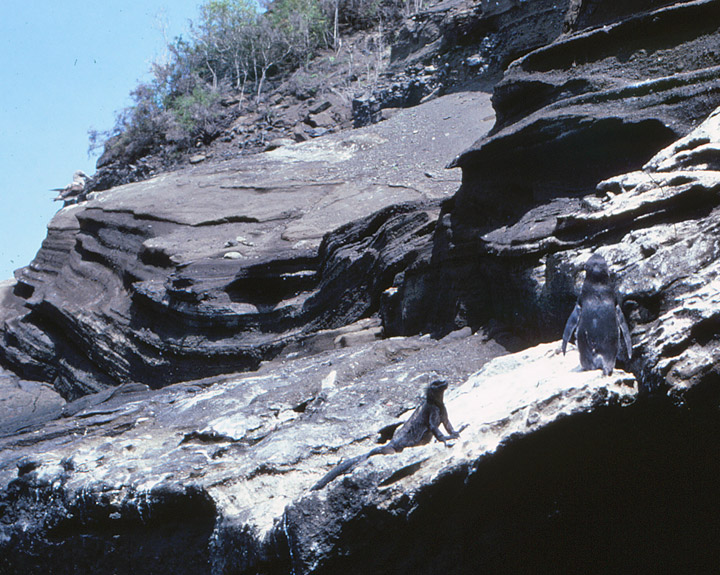
Adult males are approximately 1.3 m long, females 0.6 m, males weigh up to 1.5
kg.

As a cold blooded animal, the marine iguana can spend only a limited time in the
cold sea, where it dives for algae. However, by swimming only in the shallow
waters around the island they are able to survive single dives of up to half an
hour at depths of more than 15 m. After these dives, they return to their
territory to bask in the sun and warm up again. When cold, the iguana is unable
to move effectively, making them vulnerable to predation, so they become highly
aggressive before heating up (since they are unable to run away they try to bite
attackers in this state). During the breeding season, males become highly
territorial. The males assemble large groups of females to mate with, and guard
them against other male iguanas. However, at other times the species is only
aggressive when cold.

Marine iguanas have also been found to change their size to adapt to varying
food conditions. During El Niño conditions when the algae that the iguanas feed
on was decreased for a period of two years, some were found to decrease their
length by as much as 20%. When food conditions returned to normal, the iguanas
returned to their pre-famine size. It is speculated that the bones of the
iguanas actually shorten as a shrinkage of connective tissue could only account
for a 10% length change.
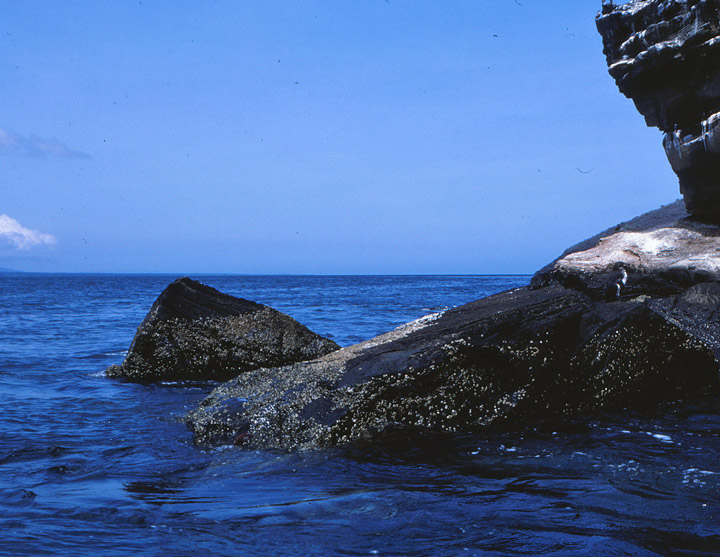
This species is completely protected under the laws of Ecuador, and is listed
under CITES Appendix II. El Niño effects cause periodic declines in population,
with high mortality, and the marine iguana is threatened by predation by exotic
species. The total population size is unknown, but is, according to IUCN, at
least 50,000, and estimates from the Charles Darwin Research Station are in the
hundreds of thousands.
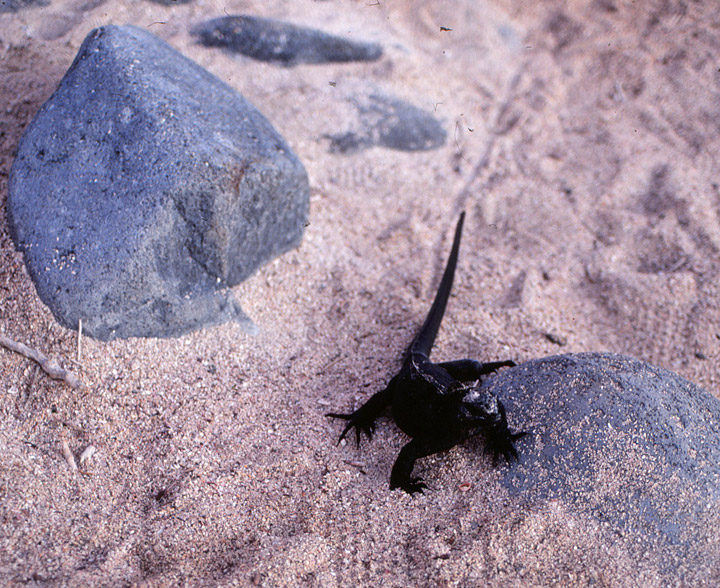
The marine iguanas have not evolved to combat newer predators. Therefore, cats
and dogs eat both the young iguanas and dogs will kill adults due to the
iguanas' slow reflex times and tameness. Dogs are especially common around human
towns and can cause tremendous predation. Cats are also common in towns, but
also occur in numbers in remote areas, where they take a toll on iguanas.
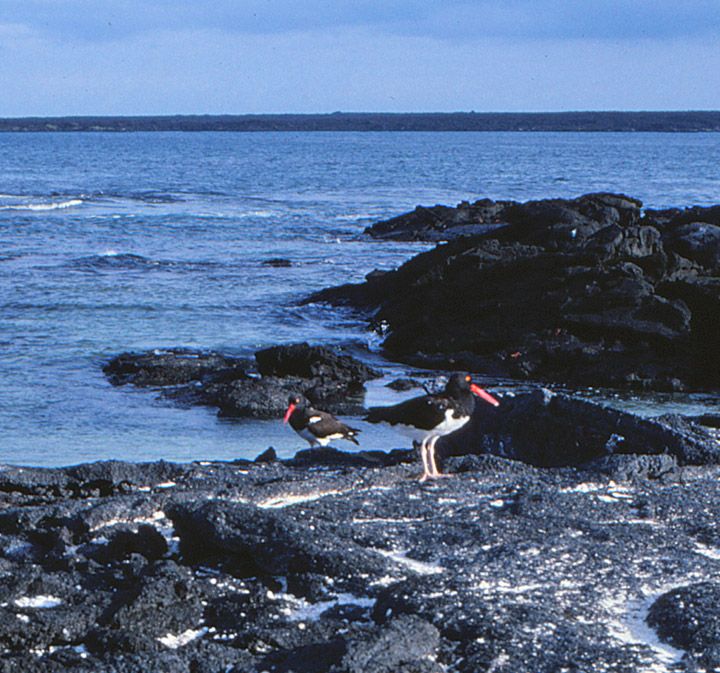
Researchers theorize that land and marine iguanas evolved from a common ancestor
since arriving on the islands from South America, presumably by driftwood. It is
thought that the ancestral species inhabited a part of the volcanic archipelago
that is now submerged.
A second school of thought holds that the Marine iguana may have evolved from a
now extinct family of sea-going reptiles.
Text from Wikipedia
Return to Galapagos Island page